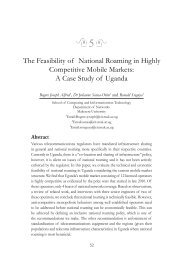Undergraduate Handbook - School of Computing and Informatics ...
Undergraduate Handbook - School of Computing and Informatics ...
Undergraduate Handbook - School of Computing and Informatics ...
Create successful ePaper yourself
Turn your PDF publications into a flip-book with our unique Google optimized e-Paper software.
Non verbal communication clues; Presentation seminars, seeking clarification etc.; Expression <strong>of</strong><br />
politeness; Public speaking; Proper listening skills.<br />
• Examination Skills; Preparing for examinations: How much one gets from group discussions; Proper<br />
revision; Underst<strong>and</strong>ing examination rubric; Budgeting time during examination process; Writing<br />
examinations <strong>and</strong> following instructions<br />
Reference Books:<br />
i. B. Bough, 101 ways to improve your communication skills instantly, 4th edition, 2005.<br />
ii. P. Klavs, The hard Truth About s<strong>of</strong>t skills: Work Place Lessons Smart People wish they had learned sooner,<br />
2008.<br />
CSC 1100: Computer Literacy (4 CU)<br />
Course Description: In this course, students are to learn about the basic organization, concepts <strong>and</strong> terminologies in<br />
a computerized environment. They are also to get an in depth underst<strong>and</strong>ing <strong>of</strong> common computer applications. The<br />
use <strong>of</strong> related applications in different operating systems will be explored. The aims <strong>of</strong> the course unit are to: Equip<br />
students with basic knowledge about computer organization; Equip students with skills <strong>of</strong> using common <strong>of</strong>fice<br />
applications; Expose students to different operating systems; Equip students with skills <strong>of</strong> how to use the Internet;<br />
<strong>and</strong> equip students with knowledge about common text editors in different operating systems. On completion <strong>of</strong> this<br />
course unit, the students will be able to: Describe the different parts <strong>of</strong> a computer; describe the historical evolution<br />
<strong>of</strong> computers; competently use the common <strong>of</strong>fice applications in at least two operating systems <strong>and</strong> competently<br />
use common text editor in at least two operating systems.<br />
Indicative Content: General computer organisation; Historical perspectives <strong>of</strong> computing; common Micros<strong>of</strong>t<br />
<strong>of</strong>fice packages; <strong>of</strong>fice packages in other operating systems; text editors; Common Linux <strong>and</strong> Using the web.<br />
Reference Books:<br />
i. J. Preston, R. Ferret <strong>and</strong> S. Gaskin, Computer Literacy, 2007.<br />
ii. J. Janrich <strong>and</strong> D. Oja, Practical Computer Literacy, 2001.<br />
BIT 1102 Communications Technology & Internet (3 CU)<br />
Course Description: This course is intended to be at the introductory level in a curriculum <strong>and</strong> to provide<br />
foundation skills for subsequent network-related courses, for example, Internet Programming. It provides an<br />
overview <strong>of</strong> Communications Technology <strong>and</strong> Internet. The goal is to help students underst<strong>and</strong> the role <strong>and</strong> meaning<br />
<strong>of</strong> Communications Technology <strong>and</strong> Internet in the contemporary world. The course aims to: Give students main<br />
guidelines for the future study <strong>of</strong> networks-related courses; Develop their knowledge <strong>and</strong> underst<strong>and</strong>ing <strong>of</strong> core<br />
networking concepts <strong>and</strong> technologies; Internet <strong>and</strong> intranet tools; basics <strong>of</strong> networking protocols; basics <strong>of</strong> network<br />
security; core Internet infrastructure; personal, business, social, legal <strong>and</strong> ethical implications <strong>of</strong> Internet governance<br />
Indicative Content: Networking Concepts; Internet <strong>and</strong> Intranet Tools; Protocols; Security; Internet; Infrastructure<br />
<strong>and</strong> Governance – Personal, Business, Social, Legal <strong>and</strong> Ethical; Implications<br />
Reference Books:<br />
i. D. E. Comer, The Internet Book, Prentice Hall Inc., Upper Saddle River, 2000.<br />
ii. D. Amor, Internet Future Strategies: How Pervasive <strong>Computing</strong> Services Will Change the World, Prentice<br />
Hall Inc., Upper Saddle River, 2002.<br />
iii. I. Zeid, Mastering the Internet <strong>and</strong> HTML, Prentice Hall Inc., Upper Saddle River, 2000.<br />
iv. Internet Getting Started, Editions ENI, Nantes, 2001.<br />
v. A. E. Grant, J. H, Meadows, Communication Technology Update <strong>and</strong> Fundamentals, Focal Press, 2008.<br />
vi. M. Mirabito, B. Morgenstern, The New Communications Technologies, 5th edition: Applications, Policy,<br />
<strong>and</strong> Impact, Focal Press, 2004.<br />
105

















